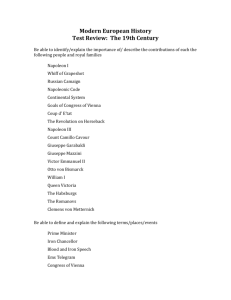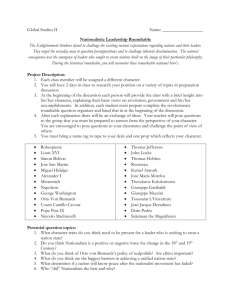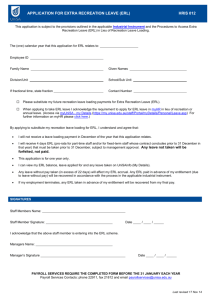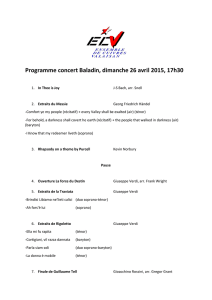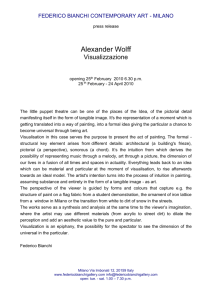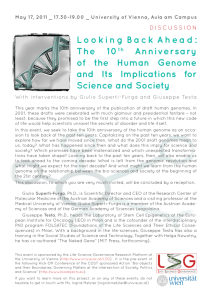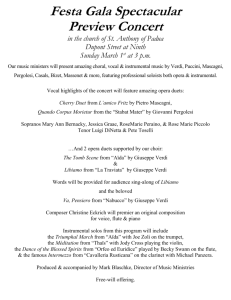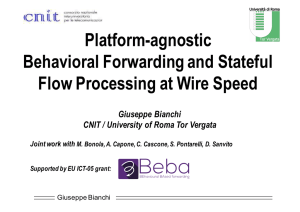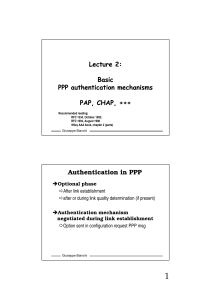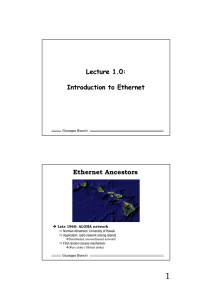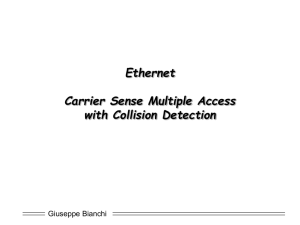Traffic Intensity
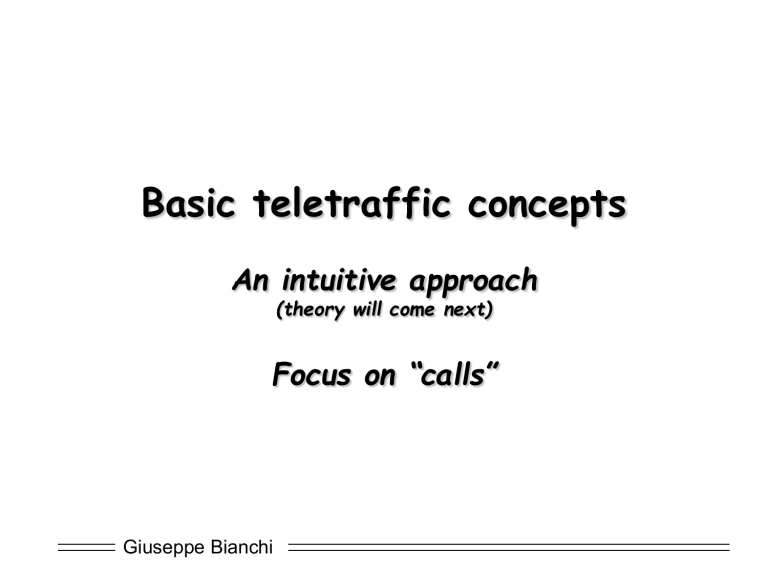
Basic teletraffic concepts
An intuitive approach
(theory will come next)
Focus on “calls”
Giuseppe Bianchi
1 user making phone calls
TRAFFIC is a “stochastic process”
BUSY 1
IDLE 0 time
How to characterize this process?
statistical distribution of the “BUSY” period
statistical distribution of the “IDLE” period
statistical characterization of the process “memory”
E.g. at a given time, does the probability that a user starts a call result different depending on what happened in the past?
Giuseppe Bianchi
Traffic characterization suitable for traffic engineering traffic amount intensity
A i
lim
t
average number
of calls of busy time
t per min in
t
average call duration
probabilit y that, at a random time t, user is in BUSY state
min
mean process value
All equivalent (if stationary process)
Giuseppe Bianchi
Traffic Intensity: example
User makes in average 1 call every hour
Each call lasts in average 120 s
Traffic intensity =
120 sec / 3600 sec = 2 min / 60 min = 1/30
Probability that a user is busy
User busy 2 min out of 60 = 1/30 adimensional
Giuseppe Bianchi
U1
Traffic generated by more than one users
Traffic intensity
(adimensional, measured in Erlangs):
U2
A
i
4
1
A i
4 A i
U3
U4
P
k active calls
E
active calls
4 k
A i k
1
A i
4
k
4
A i
A
TOT
Giuseppe Bianchi
example
5 users
Each user makes an average of 3 calls per hour
Each call, in average, lasts for 4 minutes
A i
3 calls hour
4
60
hours
5
A
5
1
5
Meaning: in average, there is 1 active call; but the actual number of active calls varies from 0 (no active user) to 5 (all users active), with given probability
Giuseppe Bianchi number of active users probability
0 0,327680
1
2
3
4
5
0,409600
0,204800
0,051200
0,006400
0,000320
Second example
30 users
Each user makes an average of 1 calls per hour
Each call, in average, lasts for 4 minutes
A
30
1
4
2 Erlangs
60
SOME NOTES:
-In average, 2 active calls (intensity A);
-Frequently, we find up to 4 or 5 calls;
-Prob(n.calls>8) = 0.01%
-More than 11 calls only once over 1M
TRAFFIC ENGINEERING: how many channels to reserve for these users!
Giuseppe Bianchi n. active users binom
0
1
2
3 probab cumulat
1 1,3E-01 0,126213
30 2,7E-01 0,396669
435 2,8E-01 0,676784
4060 1,9E-01 0,863527
7
8
9
4
5
6
27405 9,0E-02 0,953564
142506 3,3E-02 0,987006
593775 1,0E-02 0,996960
2035800 2,4E-03 0,999397
5852925 5,0E-04 0,999898
14307150 8,7E-05 0,999985
16
17
18
19
20
21
10
11
12
13
14
15
30045015 1,3E-05 0,999998
54627300 1,7E-06 1,000000
86493225 1,9E-07 1,000000
119759850 1,9E-08 1,000000
145422675 1,7E-09 1,000000
155117520 1,3E-10 1,000000
145422675 8,4E-12 1,000000
119759850 5,0E-13 1,000000
86493225 2,6E-14 1,000000
54627300 1,2E-15 1,000000
30045015 4,5E-17 1,000000
14307150 1,5E-18 1,000000
22
23
24
25
26
27
28
29
30
5852925 4,5E-20 1,000000
2035800 1,1E-21 1,000000
593775 2,3E-23 1,000000
142506 4,0E-25 1,000000
27405 5,5E-27 1,000000
4060 5,8E-29 1,000000
435 4,4E-31 1,000000
30 2,2E-33 1,000000
1 5,2E-36 1,000000
A note on binomial coefficient computation
60
12
60 !
12 !
48 !
1 .
39936 e
12 but 60 !
8 .
32099 e
81 ( overflow problems!
!
)
60
12
exp
log
60
12
exp
log
log
log
exp
i
60
1 log
i
12
1 log
i
48
1 log
(no overflow!
!
before exp...)
60
12
A i
12
1
A i
48
exp
i
60
1 log
i
12
1 log
(no overflow!
!
never!
)
i
48
1 log
12 log
i
48 log
1
A i
Giuseppe Bianchi
Infinite Users
P
Assume M users, generating an overall traffic intensity A
(i.e. each user generates traffic at intensity A i
We have just found that
=A/M).
M
P k active calls, M users
M k
A i k
1
A i
M
k
M
M
k
!
!
k !
A
M
k
A
M
k
A
M
Let M infinity, while maintaining the same overall traffic intensity A
k active calls,
users
M lim
M
M
!
k
!
1 k !
A k
M k
A
M
M
1
A
M
k
A k k !
lim
M
M
M
1
M
M k
k
1
1
A
M
M
A
A
1
A
M
k
e
A
A k k !
Giuseppe Bianchi
P k
Poisson Distribution
30%
25%
20%
A=2 erl poisson binomial (M=30)
A=10 erl
15%
10%
5%
0%
0 2 4 6 8 10 12 14 16 18 20 22
e
A
A k k !
Very good matching with Binomial
(when M large with respect to A)
Much simpler to use than Binomial
(no annoying queueing theory complications)
Giuseppe Bianchi
Limited number of channels
THE most important problem in circuit switching
The number of channels
C is less than the number of users M (eventually infinite)
U2
U3
Some offered calls will be
“blocked”
What is the blocking probability?
U4
We have an expression for
P[k offered calls]
We must find an expression for
P[k accepted calls]
As:
P [ block ]
P
C accepted calls
TOT
Giuseppe Bianchi
X
X
No. carried calls versus t
No. offered calls versus t
Channel utilization probability offered traffic: 2 erl - C=3
C channels available
Assumptions:
Poisson distribution (infin. users)
Blocked calls cleared
It can be proven (from
Queueing theory) that:
35%
30%
25%
20%
15%
P [ k calls
C
P
in the system, k offered
P
i offered calls calls
k
i
0
(0, C) ]
10%
5%
0%
0 1 2 3 4 offered calls accepted calls
5 6
(very simple result!)
Hence:
P [ system full ]
P [ C accepted calls ]
P
C offered calls
i
C
0
P
i offered calls
Giuseppe Bianchi
7 8
Blocking probability: Erlang-B
Fundamental formula for telephone networks planning
A o
=offered traffic in Erlangs
Efficient recursive computation available
E
1 , C
o
C
A o
E
1 , C
A o
1
E
1 , C
1
A o
o
A o
C
block
j
C
0
C !
A o j j !
E
1 , C
o
100,00%
10,00%
1,00%
C=1,2,3,4,5,6,7
0,10%
0,01%
0 1 2 3 offered load (erlangs)
4 5
Giuseppe Bianchi
NOTE: finite users
Erlang-B obtained for the infinite users case
It is easy (from queueing theory) to obtain an explicit blocking formula for the finite users case:
Erlang-B can be re-obtained as limit case
M infinity
A i
0
M·A i
A o
Erlang-B is a very good approximation as long as:
A/M small (e.g. <0.2)
ENGSET FORMULA:
block
A
C i
M
C
1
k
C
0
A i k
M
i
1
A i
A o
M
Giuseppe Bianchi
In any case, Erlang-B is a conservative formula
yields higher blocking probability
Good feature for planning
Capacity planning
Target: support users with a given Grade Of
Service (GOS)
GOS expressed in terms of upper-bound for the blocking probability
GOS example: subscribers should find a line available in the
99% of the cases, i.e. they should be blocked in no more than
1% of the attempts
Given:
C channels
Offered load A o
Target GOS B target
C obtained from numerical inversion of B target
E
1 , C
o
Giuseppe Bianchi
Channel usage efficiency
Offered load (erl)
A o
C channels
Carried load (erl)
A c
A o
1
B
A o
B efficiency :
A c
C
Blocked traffic
A o
1
E
1 , C
C
o
A o if small blocking
C
Fundamental property: for same GOS, efficiency increases as C grows!! (trunking gain)
Giuseppe Bianchi
example
100,0%
10,0%
1,0%
A = 40 erl
A = 60 erl
A = 80 erl
A = 100 erl
0,1%
0 20 40
GOS = 1% maximum blocking.
Resulting system dimensioning and efficiency:
Giuseppe Bianchi
60 capacity C
80 100
40 erl C >= 53
60 erl C >= 75
80 erl C >= 96
100 erl C >= 117
= 74.9%
= 79.3%
= 82.6%
= 84.6%
120
Erlang B calculation - tables
Giuseppe Bianchi
